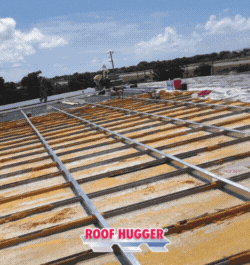some of my desert home pics test
« Back To Roofers TalkNone taken Rocky. It took more than one time before I realized GP was encouraging dutch lap beofre I woud believe it. The GAF, GP, and other reps all said that by never allowing water into a joint by not having a joint anyway,the roofs would last much longer, as noted by Egg. I've seen the same thing too. They'll outlive a similar roof, side by side on the same block by many years.
woody, I would tend to agree with you on the fire under the tile being hot enough and left in the kiln long enough, should hold water. There is an EPA problem with emissions out this way and California, that has driven the cooking to south of the border. Regardless, everybody seems to be cooking faster so they can produce more with less emissions and so we dont get the hardness that other mfger's may get. MCA, Redlands, U.S. Tile, they've used up all their EPA credits. They borrow credits from each other, from the future, from other industries. Still not enough so they burn faster which makes a less hard tile. Clay pipes have been leaking for centuries also, ever so slowly. I had lunch with Ludiwici Reps acouple months ago.They asked if I would be exclusive. The transportation costs pushed them out of even my market, which is highend homes. By the time it would take to get them esstablished I would have lost so much to competition on my old standby's. Had to nix that. Tinner, I meant no offence :laugh: That other shingle job you showed looked real nice, for a tinman. :P Egg, you sound more like an artist.
Many years ago, a GC insisted I use shingles and make it work on his lo-pitch addition. Used ELKS, 1 layer of cheap I&W, 4" exposure and 6" minimum dutchlap. Still holding up to this day, and we've had winters where 14" to 20" of snow sat there for days. Took about 8 sq. or 9sq. to do.
http://www.rooferscoffeeshop.com/show_album_photo.asp?userid=30&AlbumID=288&file=1976&s=0
You have that right Egg. It was hard and time consuming. Should never lap less than an inch. NEVER across a two-layered end, switch from 1-1/4" nail at the lap to 1-1/2", etc.
GP was the first to suggest to when I did a dome. THey spec'd dutch-lap design.
I remember those shingles. Certainteed is making one now to break up the pattern. Timberline had a dutchlap.
I was shingling in the 60's, and onwards.
On a related note, related to the intrinsic worth of roofers as different from other tradesmen, I've got whole sermons too lengthy to repeat here and besides, I know I would be only preaching to the choir.
In a nutshell, what we need to provide that other intelligent, skilled tradesman can't, is the intimate knowledge of the physical properties and behavior of the three forms of water in differing conditions, especially how sticky it is and given multiple options which routes it prefers to take and why it would take others, and the ways material age over time and the effects that has on water-shedding systems. How and why things can and would change. This takes time and it takes mind. You add to that the willingness and ability to withstand the strain, the heat, the intensely dirty conditions and you have a rare bird.
You can get people to go into the pit and bust rock to stay alive. Most of them just can't sing. If we want to elevate, we have to take really good care of the ones who can.
Frank, not sure if you were involved with comp shingles in the seventies, (I know you were involved in the trade, just not sure what mediums) but the very first shot anyone took (that I know of) at the laminate look was when Certainteed put out its Hallmark 'Shangle.' Ok, so this was a heavy three-tab (the Glasstex, formerly Woodtex) with narrow strips of like material randomly glued onto the face, top to bottom. It worked and it definitely achieved its goal, eliminating the patterning. At that time also, dutchlaps were just disappearing from the market. Man, those things lasted and lasted. They, too, were made from uniform stock. After awhile, though they hung in there for up to forty years with unbelievable tenacity, they became noticeably sunken wherever the stacked material stopped. They handled that stress ok and went full-term, even beyond.
But. The weakest spot on the laminates is the first inch above the top of the laminated strip at either extreme end of the shingle. They tear quite easily there. Water wants to pool there and it wants to get into the butt-joints there. I realize that's why you are endorsing it. But that drop from three layers (with the headlap counted) to two can be problematic if some care isn't taken. When you dutchlap that edge you are going from five layers to three, sometimes with a continuously laminated edge and sometimes without, depending on the shingles in play, considerably worse than three to two. Given the limitations of the material, I consider it an unsound stressful condition and the overlaying shingle has to jump up over two plys of material, which it definitely doesn't like to do.
Rocky, you can go low-tech with the copper. If you invest in a three-foot sliproll you are instantly there. With a four-foot brake, the sliproll, and a collection of hand tools, you can layout and do for concrete tile profiles too. If you want to do miles of roof to wall you'd definitely want to tool up more than that. I either won't or can't or haven't or some combination of all those lacks of commitment. I just like hand-building job to job as the mood strikes me. O'Hagin points the way. Craftsmanship really has no limit. Old School shows that afresh with the custom woodwork. We expect that type of creation from carpenters and artists. We just have a tendency to assume that roofers can't make things from scratch. They can. At least they should be able to.
:laugh: Thought you'd say that Rocky. :) Due to storms rolling in and then a hurricane, I didn't take the time to cut 4's and 6's to weave in at 18" intervals. Would have broken all patterns then.
Thanks OS. dont know if it made sense but that's my opinion. I have some more photos from another house in progress, whadda think? Should i post 'em?
Geez, I leave for a week and come back to a lot of long winded opinions. This is really making for great for discussion. Let me take a deep breath and, as somebody quoted, let me give my opinion, on most of the remarks. I would like to think I m an expert at what I do, but everyday it seems I learn something new about roofing. Like those copper scuppers, oops, Sorry Egg. Let me tell you, that that was some fancy idea. I had never seen that before, copper tile? I loved it and have shown others and they have never seen them either. I will use that on some of my projects. And your 2 piece work looks great. Tinner, that shingle over lay looks terrible, my opinion, I was able to almost duplicate that by going over a curled wood shingle roof, upon the insistence of the home owner. He was happy when I finished, I was not. It is still shedding water and the HO got what he wanted. My opinion on, to underlay or not. It all depends on the structure your working on and the type of system you're installing. Now I live in a desert and don't get but maybe 6-7" of rain a year. Very few houses here that are more than 60 years old, so we are not going to run into many challenging re-roofing projects that are 100-200year old home like some of you guys find. What we do have here though, in our custom home market, is some very demanding, architecturally challenging, innovatively designed homes and builders. Most of the customs I work on are designed to look and replicate the materials and installation techniques brought from the old country, albeit ,via Mexico, Brazil, Argentina. All places that were conquered by the Spaniards, Portuguese, Dutch and others. In the" old days" when roofs were installed with out felts, they almost always had no ceilings. There was no such thing as a ceiling. The space we now call an attic was all part of the living space and hence was conditioned air. Once ceilings were installed and insulation was placed on the ceiling you then separated the two spaces. One condition air, the other, unconditioned air. The air from the conditioned space flowed thru the ceiling/insulation and created additional moisture in the attic which wasn't good for the structure. Moisture created rot and mildew. Scientists figured the best way to handle this was to put felt paper to direct the air and put ventilation holes in the roof,to move the air and allow the moisture to escape. Before the invention of attics the air was simply allowed to escape thru the open sheathing and the spaces between the tiles or stone work Slate, Cotswold, and even Thatch. There has never been a piece of clay tile, with out a slurry burnt on to it, that has been waterproof. If you were to block up both ends of the tile and fill it with water the clay would soak up the water and then start leaking thru. Generally speaking, the water runs off so fast that the clay doesn’t soak up the water and if it does, because of the pitch, gravity continues to pull the water down hill to the next tile and then the next…. Until it drips or runs off the last tile As for slate, wood shingles as well as other tiered applied materials, the small exposure and double coverage was a sure fire way to keep water out. Example: a 18†wood shingle with a 5’ exposure gave you a 3†head lap on the 3rd and every course following, thus making it nearly impossible for water to penetrate, unless your fasteners were in the wrong place.
Wywoody, that house was a wood frame house. The rock stops below the roof and restarts above the roof. The walls are all wrapped with the 3ply torch, all the cooper flashings have large wallside faces, a small “Z†bar flashing and an iron lentil (angle iron) to hang the rock on. The large wall side flashing is to facilitate the, God forbid, unlikely need to repair the roof sometime in the future. With the upgraded underlayment, the techniques used along the walls, the foam set which a 220 lb man can run across, the HO is hoping he has no roof issues for a couple hundred years and has the look of a home that is 200 years old. There are no nails in this roof, hopefully the foam set holds true and the mortar does its job as well. Spare the expense, hell, he had the tile shipped from Italy when we had local stock just as good. Finally, I would like to add that I think roofing is as much an Art as it is a Science. Both functionally and aesthetically I agree with EGG that any roofing material should not be considered merely decorative cladding and underlayment should only be a secondary defense.
I can see how the foam-set would be ideal for running serpentine patterns.
I missed your two posts TomB. Right on! And let's point out that any roof material worth a hoot will outlast any underlay by 100+ years. :)
egg....Indeed, a pet-peeve.....and your 3 cents is dead-on....However, with all due respect; I won't be doing any hand-wringing over the cpmpatibility of redwood, cedar, wolmanized wood, tree sap, felt, metal fasteners, as they've all been in contact for centuries with, (to my knowledge), no ill affects.
You won't get any flak from me Egg. When I have felt, I'll even use it. When I don't, I keep on roofing. If the weather reaches the felt, or I&W, you've lost and it's only a case of when' it shows up. But the leak is there. No 'if's'
To date I have always had an ample supply of redwood or cedar for batten stock. The corrosion issue is worth some investigation, not just for the effect on fasteners but for the effect on underlayments.
Speaking of underlayments, I have noticed over the years that TomB has brought the issue up at regular intervals and like some of my own topics that bring up intermittently, it qualifies as what the world would call a pet peeve. Read on before reacting. MikeNZ raised the same issue and supported it with photos on several occasions. He doesn't do tile, but is a reliable observer.
One could easily try to write this objection off as an "opinion" as if to say that is somehow less worthy than some quantifiable test analysis or industry standard set by committees of engineers, architects, etc. and it's true, it IS an opinion. But it is also a fact.
Wood shingle sidewall is (or always used to be...no telling what age-old observably-provable truth has been revised these days) considered a "decorative cladding." Hence it traditionally required underlayment to serve as waterproofing. Have we really fallen so low as to reach the point where traditional materials like tile and even composition shingles, are now to be considered decorative cladding?
It has been my experience that for tile (leaving Florida wind out of it and leaving ice damming and deep snow-loads out of it) the ONLY things that compromise the mechanical waterproofing of a normal system are 1) build up of debris, 2) improper lay-out, 3) protection of hips and ridges. They work just fine without underlayment.
So much for what the French call "mechanical tile" which involves the interlocking sidelaps and battens. It is my personal opinion that two-piece mission tile does require underlayment to give security although I have wired it down to open structures where there are no contents below that are too precious to get wet and it has worked fine. The problem with those tiles are mainly that pans break under foot traffic, very easily and not always detectably.
Tile should never be considered merely decorative cladding and underlayment should never be considered to be more than a secondary line of defense. That's my three cents.
CIAK; Never had that one come up, (and I've heard just about everything, when it comes to tile roof assemblies),....I'm not privy to any issues...One might assume that would be a primary consideration, as the very attachment involves metal fasteners....But, ya know what they say about "assume"....























